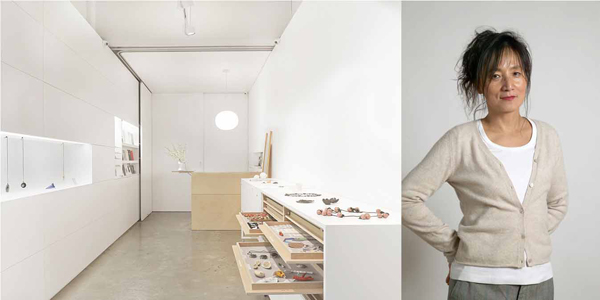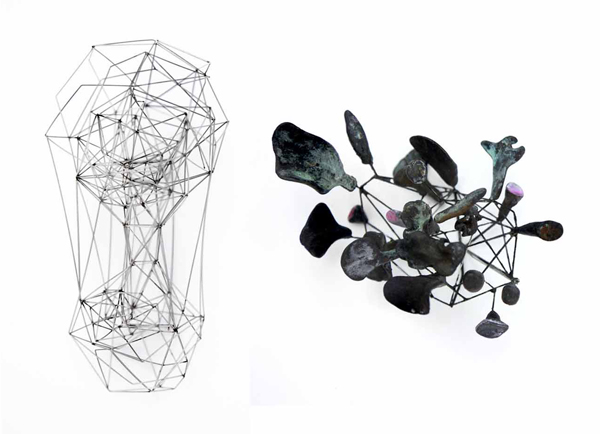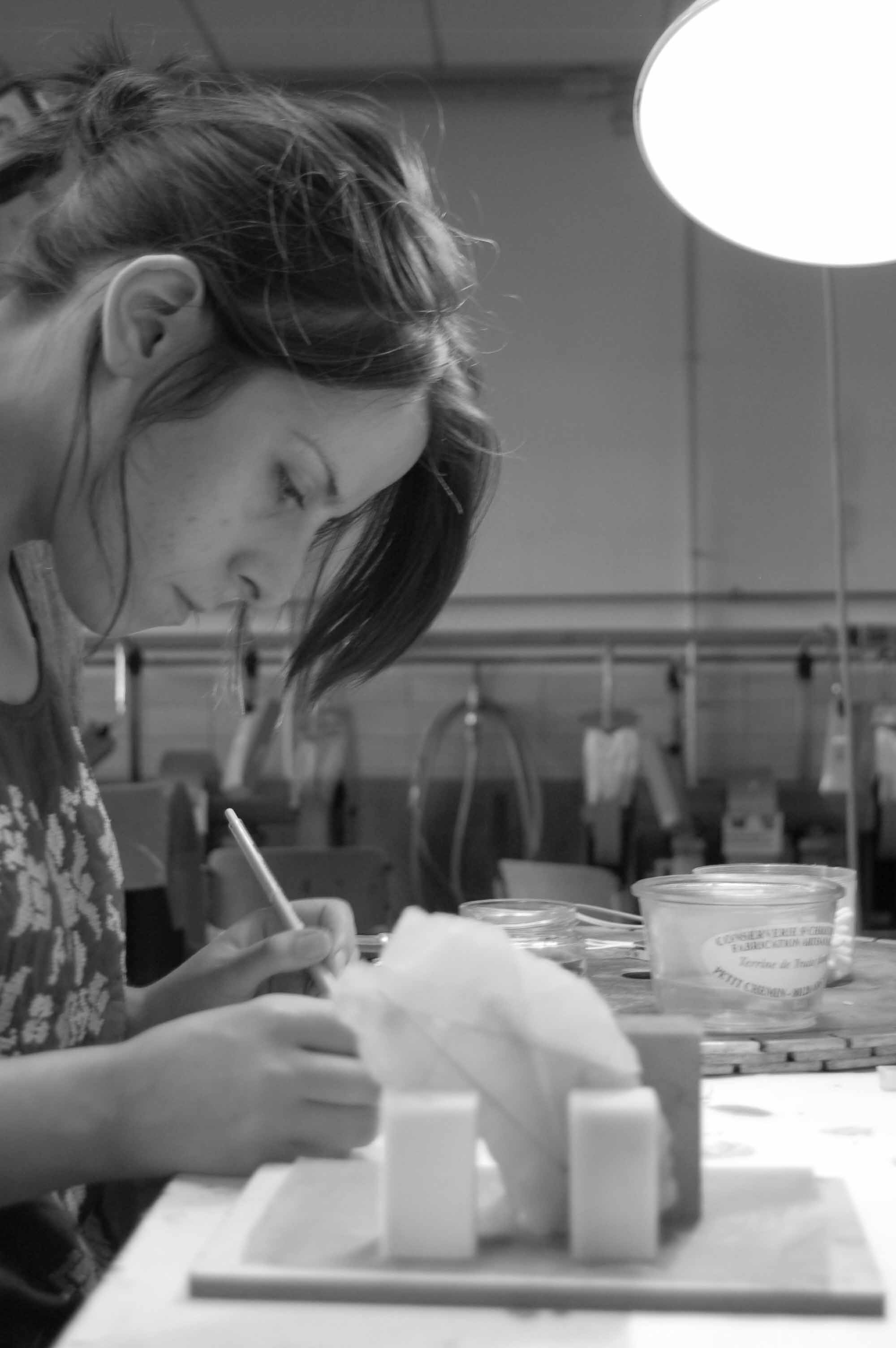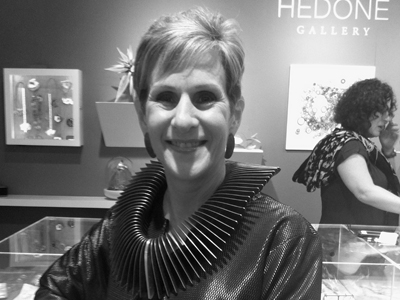Gallery Funaki recently launched the inaugural Mari Funaki Award for Contemporary Jewelry to honor and recognize Mari Funaki, a unique and passionate advocate for contemporary jewelry in Australia. This award aims to celebrate Mari’s legacy by recognizing the skills and talent of jewelers, both local and overseas, and by providing a platform for outstanding new work to be shown in Australia. Artists worldwide, at any stage of their practice, were invited to apply for the award; over 530 entries from more than 35 countries were received. The work of 31 finalists was selected and is currently on exhibit at Gallery Funaki from August 13–September 13, 2014.
The winner of the established artist category is Kiko Gianocca, from Switzerland, with a series of three necklaces collectively titled Veneer. His work has been exhibited internationally since 2003 and he is currently represented by Gallery Funaki.
In the emerging artist category, two winners were selected: Patrícia Domingues, from Portugal, with her pendant from the Duality series, and Polish artist Sara Gackowska for her brooch, Membrane, from the Methamorphosis series. In addition, two commendations were given, the first to Inari Kiuru, a Melbourne artist, for her two brooches from the Evolution series, and Jiro Kamata, based in Germany, for his Spiegel necklace.
The recent announcement of winners provided an opportunity to speak with gallery director Katie Scott about the award and her vision for the gallery, as well as hear from the three winners.

Bonnie Levine: Mari Funaki was an important visionary and maker in the world of contemporary jewelry, particularly in Melbourne. Can you tell us about her and her legacy?
Gallery Funaki recently launched the inaugural Mari Funaki Award for Contemporary Jewelry to honor and recognize Mari Funaki, a unique and passionate advocate for contemporary jewelry in Australia. This award aims to celebrate Mari’s legacy by recognizing the skills and talent of jewelers, both local and overseas, and by providing a platform for outstanding new work to be shown in Australia. Artists worldwide, at any stage of their practice, were invited to apply for the award; over 530 entries from more than 35 countries were received. The work of 31 finalists was selected and is currently on exhibit at Gallery Funaki from August 13–September 13, 2014.
The winner of the established artist category is Kiko Gianocca, from Switzerland, with a series of three necklaces collectively titled Veneer. His work has been exhibited internationally since 2003 and he is currently represented by Gallery Funaki.
In the emerging artist category, two winners were selected: Patrícia Domingues, from Portugal, with her pendant from the Duality series, and Polish artist Sara Gackowska for her brooch, Membrane, from the Methamorphosis series. In addition, two commendations were given, the first to Inari Kiuru, a Melbourne artist, for her two brooches from the Evolution series, and Jiro Kamata, based in Germany, for his Spiegel necklace.
The recent announcement of winners provided an opportunity to speak with gallery director Katie Scott about the award and her vision for the gallery, as well as hear from the three winners.

Bonnie Levine: Mari Funaki was an important visionary and maker in the world of contemporary jewelry, particularly in Melbourne. Can you tell us about her and her legacy?
Katie Scott: Sure. Mari’s influence on contemporary jewelry in Melbourne is something I don’t think can be overstated. She was instrumental in fostering the vibrant scene we have here in Australia today, and it wasn’t only via the physical fact of Gallery Funaki that she did this; it was by developing really strong relationships between makers here and overseas and between the university sector and her own commercial enterprise. These are relationships we still value and maintain today, and they’re pivotal in keeping contemporary jewelry viable and strong.
Then of course there was Mari’s own studio practice, which was staggeringly impressive. Her talent as a maker not only had a huge influence on jewelry and object-making internationally (she won the Herbert Hoffmann Prize twice and was the first Australian to do so), but it meant that those relationships she developed with other artists were based on a profound mutual respect and a really thorough “insider” understanding of what it is to make and exhibit one’s work.
Mari opened Gallery Funaki in 1995, almost 20 years ago, and until that time there was no dedicated gallery environment for jewelry in this country. She looked to gallery models overseas, in particular Galerie Ra, and was mentored by important figures like Paul Derrez in establishing her own gallery model. It’s easy to take for granted now, as there are so many more jewelry galleries worldwide, but at the time—and particularly in Australia—it was a courageous and very innovative thing to do. Mari believed in passionate and critical dialogue and also that bringing high-quality international artists to Australia was crucial in developing the outlook and sophistication of local makers who, in their turn, would travel overseas and have an impact there. This is still at the core of the gallery’s remit, and this award is a testament to that.

Katie Scott: I’ve taken a pretty “softly softly” approach since taking over the gallery four years ago; I needed to feel my way forward very carefully, given the scale of the responsibility. Central to my approach so far has been the maintenance and tending of important relationships and making sure the gallery continues as a highly respected space in which our reputation for quality and rigor isn’t compromised. I wasn’t interested in stamping my own personality on the gallery—at least initially I saw myself very much in a caretaking role.
I have made big changes over the last 18 months in the look and functionality of the gallery—physically it’s an entirely new space—and I have instigated an occasional series of project shows that seek to inject some new ideas and discussion from other disciplines into the scene. These are a work in progress and will develop over time. They can be quite a risk and I like that.
I’ve taken on several new artists, but very slowly. Given our spatial limitations, each new artist needs to bring something very special. They also need to fit within a kind of philosophical framework that lends cohesion to our whole collection. That framework is difficult to articulate and operates in some ways on a fairly gut level, but having been at the gallery now for almost ten years, day in, day out, I’m learning to trust my instincts.
At times I wish I could open a big separate project space or two, to show all the work I think is fascinating, but on the other hand, the restrictions imposed by our space force an intensity of focus that’s no bad thing. Curated group shows, like New Edition in 2013 and now the Mari Funaki Award, are a wonderful opportunity to bring visibility in Melbourne to new work from around the world, and since I’m at a point now where I’m ready to bring in new artists, it’s also a nice way of surveying the field.

Katie Scott: Essentially for three reasons: one, to bring fresh ideas and perspectives to Australia and keep our local jewelry culture vigorous and challenged; two, to give talented local artists an opportunity to show their work in a high-quality international context; and three, to keep Mari Funaki’s name and legacy alive and relevant. Time flies by so fast, and I want the next generation of makers to know who she was and why she was so special.
The idea to launch a new award in Mari’s name came out of conversations with our wonderfully supportive sponsors. Vivienne and Leo Donati, Johannes Hartfuss and Fabian Jungbeck were very close friends of Mari’s and we all remain close—collectively, we wanted to find a way to continue Mari’s objectives in a way that would allow others to honor and remember her for years to come. We hope to establish the award as a biennial event with that aim.
Mari was always focused on ways to bring examples of new jewelry here to Melbourne. We’re such a long way from anywhere and it’s important to stay connected, to keep strong currents moving between countries. Particularly for emerging and younger artists: They have to be able to see what’s going on overseas face to face, rather than just on the Internet.
What I really love about an award show like this is the unpredictability of it—we can only curate the show based on what is submitted and that provides a real sense of freshness and spontaneity. I wasn’t familiar with a number of artists in this award selection, and it’s been terrific to make those connections. It makes for an eclectic, inspiring, and surprising exhibition.
Today there are a number of different international jewelry awards given by different organizations. What distinguishes this one from other competitions?
Katie Scott: I’m not sure we set out to be especially different from other awards—the point is to reward talent and offer opportunity, and the more chances we, as a community of organizations, have to do that is a welcome and much needed thing. It’s not so much about setting ourselves apart as it is creating another incentive for makers to push themselves and make great work.
In terms of the award setup, I suppose the Mari Funaki Award is different in that it offers three prizes in two specific categories, emerging and established, rather than a winner and runners up, which is probably more common. And given that Gallery Funaki is a private commercial enterprise and not a member organization, there are undoubtedly differences in the way we’ve selected finalists. For example, I reserved my right as curator and director of the gallery to make the final selection of exhibitors, and obviously that kind of subjectivity would be less appropriate in a member organization!
Five hundred and thirty applicants from 35 countries applied for the award. Of those, 31 finalists were selected for presentation in a gallery show, and three winners, both established and emerging artists, were selected. Who were the judges, and what were they looking for as they considered these finalists?
Katie Scott: The judges were Warwick Freeman, Simon Cottrell, and Julie Ewington. Warwick and Simon are of course both eminent makers in my stable, and Julie is one of Australia’s most respected art specialists. She was until recently curatorial manager at Brisbane’s Gallery of Modern Art and has a particular interest in contemporary jewelry. She has written and lectured extensively on the topic—she recently wrote a text for Damian Skinner’s Contemporary Jewelry in Perspective.
About the award, Julie commented that “we were, of course, looking for greatness—and also to be surprised, and we found both these things. In such a distinguished field, one feels a responsibility to make a good decision. The serendipitous aspect of a prize like this means that you’re always coming to a new conversation.”
How will you recognize and support the winners after the show is over, and do you have any expectations of them?
Katie Scott: I represent Kiko Gianocca, who won the established artist prize, and we’re looking forward to planning a new exhibition with him in the not-too-distant future. The two winners of the emerging prize, Patrícia Correia Domingues and Sara Gackowska, have never been shown in Australia before and I’m talking with them both about an exhibition. Their work is very strong, both conceptually and technically, so I’m very excited to build a relationship with them.

I’ll transition now to talking with Kiko, Patrícia, and Sara. Congratulations to all three of you for being selected as winners of the first Mari Funaki Contemporary Jewelry Award! That’s quite an exciting accomplishment! Tell us a bit about your backgrounds as makers and how you got interested in jewelry.
Kiko Gianocca: I would summarize the reason I started to be interested in jewelry in one sentence—something I would have liked to have said myself but actually heard from Paul Derrez during a talk of his: “Jewelry is for the body and for the heart.” That’s how I feel if I think about the reason I chose to be a jeweler. I always thought that a piece of jewelry can be much bigger than its appearance; if a piece is successful in the eye of the wearer, it can reveal many different levels of preciousness.
Patrícia Correia Domingues: I was 15 years old the first time that I thought about jewelry. I had the opportunity to study in a very special school in Portugal, António Arroio, a school specializing only in artistic studies. I completed a course called “Art and Metals” and developed my first skills in jewelry. After that, I went to Barcelona, to the Massana School, where I found the chance to reflect on the different meanings of jewelry and creative processes. You have to experiment a lot before you can have even a small idea of where you want to go. In 2010 I decided to pursue a master’s in artistic jewelry in Idar-Oberstein, Germany. There I had the opportunity to find the materials that I like to work with the most, like stones and reconstructed material. I think the time that I spent at the University of Idar-Oberstein was a great time to acquire knowledge and start building. I have now been working for a year in my own workshop and I am very much looking forward to what comes next.
Sara Gackowska: During my second year of industrial design studies I spent most of my time in the jewelry workshop. I wanted to make objects with my hands. Before, most of my projects were visualized on the computer or partly made by myself. In 2009, I was an exchange student in Finland at Saimaa University of Applied Sciences. I fell in love with stone and stonework. I learned new techniques that allowed me to think through the material. It was a fresh experience that opened new possibilities for me. I also had the opportunity to experience the incredible atmosphere of the place, its people, events, and art exhibitions. All these elements made me feel the desire and new energy to create. That year determined my later choices and decisions so that jewelry has become my artistic expression. The aspect of jewelry that fascinates me the most is its ambiguity.

Did Mari influence you in any way?
Kiko Gianocca: Mari gave me the opportunity to show my work in her gallery and be part of her vision of jewelry. Then we became good friends and that was how she influenced me … through her friendship. She was always straightforward about good and bad things, about what she liked and didn’t. And that was the best, sincerity and frankness.
Patrícia Correia Domingues: The first time that I got to know Mari’s work was in Barcelona, in the gallery Klimt02. I don’t remember the exact year, 2007 or 2008. I was a student at Massana School at the time. I remember that I went to the opening with a friend, Nelly Van Oost, who was also selected for the Mari Funaki Award. The opening was a success; all Barcelona was there, and Mari Funaki as well. Nelly talked with her. I did not. I was too shy for that, but I did look at her pieces, and I remember how strong they were: The black forms impressed me not only by the power they released, but also by their mysterious silence. I guess Mari Funaki’s work, consciously or unconsciously, has always been an example for me.
Sara Gackowska: I am fascinated with the exceptional expression in her artwork, especially how she makes even surfaces unpredictable. Also, the way Mari developed her making process feels very familiar to me. She was a remarkable artist and great gallerist at the same time. For most people, it seems impossible. She managed these two things so that they complemented each other. Mari’s artwork and her contribution to contemporary jewelry give me a lot to think about.

What does winning this award mean for you at this point in your career?
Kiko Gianocca: To win an award or a prize gives you the chance to realize that what you created is understood and appreciated. It is a confirmation, fulfilling the process of making. When I have an idea or a sensation and there is something there that I’d like to explore, I try to follow my instinct in order to materialize it. Because the process starts within and often you are alone with it, even if you get influenced by what is around you and are somehow confronted with criticism, it is difficult to get an objective vision of what you are making. Recognition from other makers or the public—especially when they see things that you yourself didn’t yet see in your pieces—that is the best. So I think at every point in the career of a maker it is good to receive recognition like the Mari Funaki Award.
Patrícia Correia Domingues: I don’t know exactly what it means, but I am really thankful for this award. I guess this kind of thing always brings you a bit more belief and trust to keep working and fighting for what you want.
Sara Gackowska: This award is very important to me because it proves to me I am on the right track. I am sure that my participation in the Mari Funaki Contemporary Jewelry Award exhibition will create new possibilities for me and will give me the chance to take part in new exhibitions and projects. It may also lead to new contacts and artistic discussions. Besides, my motivation and enthusiasm have increased.
Best of luck to you all. Thank you.




